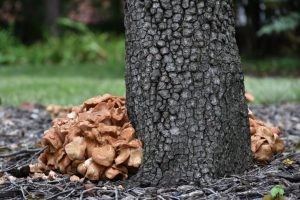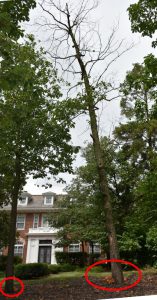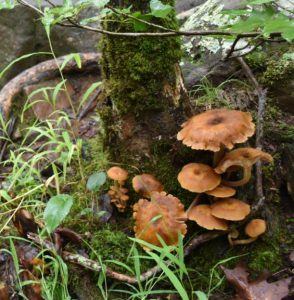A plant-loving fungus

Armillaria root rot is a problematic disease of woody plants through Florida and much of the world. There are several species of Armillaria fungi that appear quite similar, but act in the same way by infecting plants from their roots. The fruiting bodies of the fungus (i.e., mushrooms) show up in clusters around the base of the trees, but may only be present during ideal conditions. When mushrooms are not present, signs of the fungus are overall tree decline, wilting and thinning foliage, dieback (https://hort.ifas.ufl.edu/woody/dead-branche-stop.shtml), and eventual death (see below).
Vast networks of Armillaria can extend belowground, and in fact, the largest known organism in the world is a specimen of Armillaria ostoyae that covers more than 3.4 square miles in Oregon. The species in Florida do not spread as extensively, but sites with a history of Armillaria should be monitored for its spread. Another trick to test plants suspected of advanced Armillaria infection is to peel back a little of the bark – underneath there will often be white web-like structures of the fungus known as mycelium.
Management
Avoidance of infection is the best management technique. Monitoring and maintaining landscape plant health can help with disease detection. Pruning tools should always be disinfected between uses on different plants. Unfortunately, once present, there is often little a homeowner can do to mitigate its impacts. The disease can persist on both living and dead plant matter, so decreasing its presence can also mean the potential removal of infected and dead plants. Some species are more susceptible than others, and having a variety of plants can help curtail the colonization if Armillaria becomes present within your landscape. Here are some Florida landscape species based on their known susceptibility to Armillaria:
Common susceptible species:
- Southern live oak (Quercus virginiana)
- Laurel oak (Quercus laurifolia)
- Hibiscus (Hibiscus ssp.)
- Horsetail tree (Casaurina verticillata)
- Queen palm (Syagrus romanzoffiana)
Common resistant species:
- Plane trees/sycamores (Platanus ssp.)
- Crape myrtle (Lagerstroemia indica)
- Hollys (Ilex ssp.)
- Mulberries (Morus ssp.)
- Magnolias (Magnolia ssp.)
- Bald cypresses (Taxodium ssp.)
- Princess flower (Tibouchina urvelleana)
For more information on Armillaria, visit the UF EDIS page and a list of species tested for susceptibility:
 1
1


